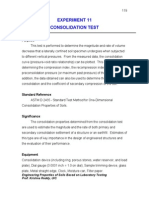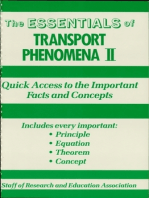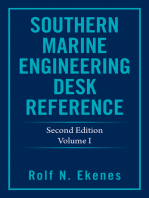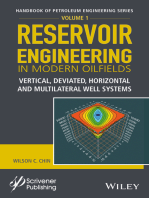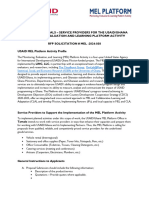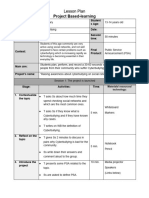1.103 Civil Engineering Materials Laboratory (1-2-3)
1.103 Civil Engineering Materials Laboratory (1-2-3)
Uploaded by
prieten20006936Copyright:
Available Formats
1.103 Civil Engineering Materials Laboratory (1-2-3)
1.103 Civil Engineering Materials Laboratory (1-2-3)
Uploaded by
prieten20006936Original Description:
Original Title
Copyright
Available Formats
Share this document
Did you find this document useful?
Is this content inappropriate?
Copyright:
Available Formats
1.103 Civil Engineering Materials Laboratory (1-2-3)
1.103 Civil Engineering Materials Laboratory (1-2-3)
Uploaded by
prieten20006936Copyright:
Available Formats
1.103 CIVIL ENGINEERING MATERIALS LABORATORY (1-2-3) Dr. J.T.
Germaine MIT Spring 2004 LABORATORY ASSIGNMENT NUMBER 9 CONSOLIDATION TEST Purpose: (1) (2) (3) (4) (5) During this laboratory you will learn about: one dimensional consolidation equipment consolidation behavior of cohesive soils relationship between drainage path and consolidation time relationship between pore pressure and surface settlement difference between secondary compression and primary consolidation 90 minute Group exercise to conduct tests
Organization: Meeting A
Note: We will have a demonstration of Steel Quenching at the end of this lab Reading: Read this handout carefully Skim ASTM D2435 on the consolidation test Lambe Chapter IX (a simple description of the test and interpretation) Lambe and Whitman Chapter 27 (presents the basic concept of consolidation theory) Overview: The consolidation test is the basic experiment to measure the settlement characteristics of a clay layer. The rate of consolidation is governed by a coupling between the hydraulic conductivity and the compressibility of the soil. For this laboratory you will measure the effect of the drainage height and the interaction between pore pressure and surface deformation. During this laboratory, you will be conducting an incremental consolidation test on a specimen trimmed from an undisturbed sample of soft clay. The oedometer has been modified to control drainage from the base of the specimen. The standard test configuration is to have both top and bottom (double) drainage. The modified test configuration has only top (single) drainage. This is achieved by closing the value at the base of the specimen. A pressure transducer measures the water pressure in a sealed chamber at the bottom of the specimen. This location is equivalent to the center plane of the specimen with double drainage. It takes from several days to a few weeks to perform a complete consolidation test. The test duration depends on the number of consolidation increments and the soil type (actually the coefficient of consolidation). A typical commercial laboratory will invest as much as 20 hours of manpower to perform the test. This being the case, it is not possible for us to perform the complete experiment for class. The entire laboratory will be performed on one test specimen.
Page 1 of 5
1.103 Lab No. 9
Each group will perform two increments on the same specimen but at different stress levels. We will setup the specimen, perform the rest of the increments, and give you the entire data set for analysis. You will be performing the more detailed calculations on the two increments that you apply but will need the entire data set to compute the compression curve. This handout outlines the proper procedure for performing the entire consolidation test. This additional information is to help you understand what was done throughout the test and is for your reference. The last page has instructions for the 1.103 assignment. Procedure: Apparatus Calibration Assemble the cell (stones, filter paper and top cap). Align assembly in the loading frame. Place a 1 lb seating load on the cell and obtain a zero reading on the displacement transducer. Apply the same loads to the apparatus as will be used in testing the specimen. At each load increment, record the displacement reading at 15 sec, 30 sec, 1 min, 2 min and 5 min. The change in dial reading gives the machine deflection curve. Apparatus preparation Assemble the oedometer (stones, filter paper and top cap) Measure the initial z3 (height between top of cap and specimen ring). You can place a dummy specimen (block of known thickness) between the filter papers for added height. Disassemble the oedometer. Grease specimen ring and cutting shoe. Determine the mass (Mr) of the empty specimen ring.
1. 2. 3. 4. 5. 6.
1. 2. 3. 4. 5.
6. Measure the height (Hr) and diameter (Dr) of the ring. 7. Measure the thickness of one piece of filter paper (Hfp). 8. Cut two pieces of filter paper. 9. Boil or ultrasound the stones for 10 minutes to clean and remove air. 10. Cut 2 wax paper disks the diameter of the specimen. Specimen preparation Remove covering from sample. Keep track of the sample orientation. Place sample on wax paper disc and glass plate. Rough cut the diameter with a wire saw to within 1/8" of final diameter. Obtain water contents from trimmings. Page 2 of 5
1. 2. 3. 4. 5.
1.103 Lab No. 9
6. Assemble sample in trimmer with extension disc supporting soil. 7. Trim sample with cutting shoe and spatula, obtain second water content. 8. Once sample is completely fitted into specimen ring, trim top and bottom with a wire saw. Make final cut on top surface with a sharp straight edge. 9. Obtain third and fourth water contents. 10. Use recess tool to create space at top of ring and trim excess soil from bottom with wire saw. Make final cut with the sharp straight edge. 11. Determine the mass of the specimen and ring (Ms+r). 12. Measure the recess from the top of ring to the soil surface (Hi) Apparatus assembly Fill base with water. Insert bottom stone into base and cover with filter paper. Remove excess water with a paper towel. Place specimen and ring on stone. Cover rim with gasket. Tighten with locking ring. Cover specimen with filter paper and top stone, allow this stone to drain before placing on soil. Place top cap on stone. Measure z3 with specimen.
1. 2. 3. 4. 5. 6. 7. 8. 9.
10. Locate assembly in loading frame with dial gauge and balance arms (this is the true weight of the assembly which is the tare load). 11. Apply one pound seating load and zero displacement transducer. Consolidation test 1. Consolidate the specimen using a load increment ratio (P/P) between 0.5 and 1.0 for loading and -0.25 and -0.50 for unloading. Note: I recommend the following schedule for class. S, 0.125, 0.25, 0.5, 1.0, 2, 4, 8,4, 1, S. 2. Fill the water bath at about 1/4 the overburden stress (0.25 ksc) or within 2 hours. 3. For each increment, record the displacement transducer reading versus time. Remember that the initial portion of the curve is very important to define the start of consolidation (s). 4. During each increment plot both root time and log time curves. 5. Apply increments after the end of primary consolidation has been reached. 6. Allow one cycle of secondary compression to occur under the maximum load and before the unload-reload cycle. 7. At the end of the test unload the specimen to the seating load and allow time for swelling.
Page 3 of 5
1.103 Lab No. 9
8. Remove the water from the bath and remove the specimen from the apparatus. 9. Remove any extruded soil and oven dry. 10. Dry the surface of the specimen and determine the mass of both soil and ring. 11. Extrude the soil and obtain water content. 12. Collect washings from filter paper and inside of ring and oven dry. Calculations: The following provides a summary description of the basic equations that are necessary to complete the test. The attached pages provide the actual equations. I hope this makes the test reduction process easier to follow. Initial Specimen Height = Hr Hi - Hfp Water Content = (total mass - dry mass)/ dry mass
Note: compute the total mass during the test by subtracting (axial deformation X Area X unit weight of water) from initial wet mass. This assumes that only water comes out of the specimen during consolidation. Void Ratio = (total volume - volume of solids)/ volume of solids Volume of solids = mass of oven dried soil / specific gravity (use 2.7) Degree of saturation = specific gravity X water content / void ratio Vertical effective stress ('v) (when the pore pressure is zero) = (Applied load - Tare load + top cap and stone)/ Area
Vertical strain (v) = (measured axial deformation - Apparatus compression )/ Initial specimen height Note: The Apparatus compression curve is attached to this assignment Compressibility (av) = - change in void ratio / change in vertical stress Note: change in void ratio is usually taken at the end of primary but for this laboratory assignment you can use end of increment values. Coefficient of consolidation (cv).(root time) = 0.848 X (drainage height)2 / time for 90% consolidation
Coefficient of consolidation (cv).(log time) = 0.197 X (drainage height)2 / time for 50% consolidation Note: Drainage height is computed at 50% consolidation for both cases. Hydraulic conductivity (kv) = (coef. of consolidation X compressibility X unit weight of water) / (1 plus average void ratio) Rate of secondary compression (c) = change in strain per log cycle of time after primary is complete.
Page 4 of 5
1.103 Lab No. 9
Report: Your report should include the following information: All the hand recorded data sheets. A graph of vertical strain vs. root time and vs. log time for the two load increments performed by your group. Perform the construction for the coefficient of consolidation on each graph for these two increments (two log and two root time). A graph of the base excess pore pressure vs. root time and vs. log time for the one load increment of your group with the bottom drainage valve closed. On each of these graphs mark the time corresponding to the end of primary consolidation you obtained from the interpretation of the strain plots. For your two increments compute the following: the void ratio at the point of 50% consolidation. the compressibility (av). the coefficient of consolidation (cv). the hydraulic conductivity (kv). rate of secondary compression for the increment with single drainage (c)
A graph of vertical strain (v) vs. log vertical stress (v) indicating end of primary, , and end of increment, . Use the Log time method to determine the end of primary strain. You only need to provide the end of primary points for your two increments. Perform the construction for the preconsolidation pressure (p) using the Casagrande construction. Additional information about the specimen, including initial specimen water content initial void ratio initial degree of saturation.
Page 5 of 5
You might also like
- Oedometer TestDocument26 pagesOedometer TestMohammadIrwanGazali90% (20)
- Experiment 3 - Jet ImpactDocument18 pagesExperiment 3 - Jet ImpactKhairil Ikram75% (4)
- Summary of Journal of Human Sexuality, Volume 1Document5 pagesSummary of Journal of Human Sexuality, Volume 1David C. PrudenNo ratings yet
- Friendships - Mediator (INFP) Personality - 16personalitiesDocument5 pagesFriendships - Mediator (INFP) Personality - 16personalitiesAmy PhicenNo ratings yet
- IT 160 Ch. 8 Activities WorksheetDocument25 pagesIT 160 Ch. 8 Activities WorksheetZak AliNo ratings yet
- UU Triaxial TestDocument11 pagesUU Triaxial Testprinces_anaNo ratings yet
- Consolidation Test1Document6 pagesConsolidation Test1Ramesh BabuNo ratings yet
- UU Triaxial TestDocument11 pagesUU Triaxial Testredz00100% (1)
- Job # 8: Consolidation Test - (Oedometer Test) : TheoryDocument6 pagesJob # 8: Consolidation Test - (Oedometer Test) : Theorysimply greenNo ratings yet
- Consolidation Test Reviwed 2023Document9 pagesConsolidation Test Reviwed 2023Zaituni SuleimanNo ratings yet
- Experiment No.15 Consolidation TestDocument9 pagesExperiment No.15 Consolidation TestKhushalchand BhandariNo ratings yet
- Consolidation Test of SoilDocument7 pagesConsolidation Test of SoilBhaskar BongaralaNo ratings yet
- Determination of Coefficient of ConsolidationDocument5 pagesDetermination of Coefficient of ConsolidationNarender CivilNo ratings yet
- Experiment 11 ConsolidationDocument26 pagesExperiment 11 ConsolidationRajeev Kusugal100% (1)
- Triaxial TestDocument18 pagesTriaxial TestTiong V YenNo ratings yet
- Consolidation Test - Lab ManualDocument5 pagesConsolidation Test - Lab ManualAmira SyazanaNo ratings yet
- Consolidation Test - (Oedometer Test)Document8 pagesConsolidation Test - (Oedometer Test)saleem razaNo ratings yet
- Triaxial TestDocument6 pagesTriaxial TestUtsav ParsanaNo ratings yet
- Consolidation TestDocument6 pagesConsolidation TestManish AryaNo ratings yet
- GRP3 EXP11 Consolidation-Test-1Document18 pagesGRP3 EXP11 Consolidation-Test-1PEÑA, Malich ANo ratings yet
- Mirpur University of Science and Technology Mirpur AJK Civil Engineering Department Geotechnical Engineering LabDocument4 pagesMirpur University of Science and Technology Mirpur AJK Civil Engineering Department Geotechnical Engineering LabShheryar BismilNo ratings yet
- Consolidation Test 6 LabDocument6 pagesConsolidation Test 6 LabManish PandiNo ratings yet
- 5 CVP321 Unconfined Compression Test Memorandum 2023Document10 pages5 CVP321 Unconfined Compression Test Memorandum 2023bvsbsgfb37663No ratings yet
- Cid CiuDocument4 pagesCid CiuRazakMaidenNo ratings yet
- Direct ShearDocument4 pagesDirect ShearQUEIZNo ratings yet
- Laboratory Manual - Consolidation TestDocument3 pagesLaboratory Manual - Consolidation TestMarcos MorrisonNo ratings yet
- Consolidation TestDocument8 pagesConsolidation TestOkello StevenNo ratings yet
- Permeability Tests: Geotechnical Engineering, Laboratory 7Document5 pagesPermeability Tests: Geotechnical Engineering, Laboratory 7Portia ShilengeNo ratings yet
- Direct Shear TestDocument24 pagesDirect Shear TestObaid Khalid100% (14)
- OedometerDocument7 pagesOedometerDaniel ShinnickNo ratings yet
- Soil Consolidation Refers To The Process by Which The Volume of A Partially or Fully Saturated Soil Decreases Due To An Applied StressDocument11 pagesSoil Consolidation Refers To The Process by Which The Volume of A Partially or Fully Saturated Soil Decreases Due To An Applied Stressngangasamwel172No ratings yet
- Apendice A-B-CDocument8 pagesApendice A-B-CSamtNo ratings yet
- CVG3109 - Lab - Consolidated Drained Tests For Sand - 2014Document11 pagesCVG3109 - Lab - Consolidated Drained Tests For Sand - 2014Rhedo.AbdNo ratings yet
- Batch SedimentationDocument4 pagesBatch SedimentationJade Dhalle Encarnacion100% (1)
- Unconfined Compression TestDocument4 pagesUnconfined Compression TestNarender CivilNo ratings yet
- ConsolidationDocument42 pagesConsolidationalishagarcia01No ratings yet
- Shear Box TestDocument13 pagesShear Box TestNoor100% (1)
- Test 09Document6 pagesTest 09Ateafac Anastasia NjuafacNo ratings yet
- LAB 14 - One-Dimensional Consolidation - Oedometer - Level 0 - 2ndDocument6 pagesLAB 14 - One-Dimensional Consolidation - Oedometer - Level 0 - 2ndAmirah ShafeeraNo ratings yet
- Lab 8 - Ciu, Cid Triaxial TestDocument7 pagesLab 8 - Ciu, Cid Triaxial TestAmirah Shafeera0% (1)
- Consolidation Test: Need and ScopeDocument6 pagesConsolidation Test: Need and ScopeSwapan PaulNo ratings yet
- School Report 2Document90 pagesSchool Report 2tony frankNo ratings yet
- Triaxial Compression TestDocument17 pagesTriaxial Compression Testsajjad.ghazai2001No ratings yet
- Lab Report ON Determinination of The Consolidation Properties of SoilDocument12 pagesLab Report ON Determinination of The Consolidation Properties of SoilRejjuwwal MehRaNo ratings yet
- 4 CVP321 UU Compression Test Memorandum 2023Document10 pages4 CVP321 UU Compression Test Memorandum 2023bvsbsgfb37663No ratings yet
- Tri Axial TestDocument10 pagesTri Axial TestAskart Nano Crime-artNo ratings yet
- Theory:: Coefficient of Volume ChangeDocument8 pagesTheory:: Coefficient of Volume ChangeJohn Pierce GumapacNo ratings yet
- CVG3109 Lab Vane Shear Test 2014Document9 pagesCVG3109 Lab Vane Shear Test 2014Terry Jenkins100% (2)
- Oedometer Test: Soil Mechanics 2 CE PC 504Document26 pagesOedometer Test: Soil Mechanics 2 CE PC 504SumanHaldarNo ratings yet
- Final Last TwoDocument9 pagesFinal Last TwoAkmal MohsinNo ratings yet
- Oedometer and Direct ShearDocument58 pagesOedometer and Direct ShearGloria AtwebembeireNo ratings yet
- UCTDocument10 pagesUCTMohd Syafiq AkmalNo ratings yet
- Test On Soils Direct, TriaxialDocument26 pagesTest On Soils Direct, TriaxialSpiderman THE SaviourNo ratings yet
- 1D Consolidation Test Lab ManualDocument15 pages1D Consolidation Test Lab Manualogul100% (2)
- Laporan Praktikum Mekanika Tanah Direct Shear Test UIDocument11 pagesLaporan Praktikum Mekanika Tanah Direct Shear Test UIsipilPI12No ratings yet
- 23 Oedometer Consolidation (Level 0)Document8 pages23 Oedometer Consolidation (Level 0)Taylor GreysonNo ratings yet
- Fluid Dynamics in Complex Fractured-Porous SystemsFrom EverandFluid Dynamics in Complex Fractured-Porous SystemsBoris FaybishenkoNo ratings yet
- Southern Marine Engineering Desk Reference: Second Edition Volume IFrom EverandSouthern Marine Engineering Desk Reference: Second Edition Volume INo ratings yet
- Reservoir Engineering in Modern Oilfields: Vertical, Deviated, Horizontal and Multilateral Well SystemsFrom EverandReservoir Engineering in Modern Oilfields: Vertical, Deviated, Horizontal and Multilateral Well SystemsNo ratings yet
- Respiration Calorimeters for Studying the Respiratory Exchange and Energy Transformations of ManFrom EverandRespiration Calorimeters for Studying the Respiratory Exchange and Energy Transformations of ManNo ratings yet
- All 115 1 Catalogo GPL 2011Document36 pagesAll 115 1 Catalogo GPL 2011prieten20006936No ratings yet
- 1.0 Appendix - Dealing With Uncertainty 1.1 TheoryDocument8 pages1.0 Appendix - Dealing With Uncertainty 1.1 Theoryprieten20006936No ratings yet
- 1.105 Solid Mechanics Laboratory: Least Squares Fit of Straight Line To DataDocument3 pages1.105 Solid Mechanics Laboratory: Least Squares Fit of Straight Line To Dataprieten20006936No ratings yet
- 1.105 Solid Mechanics Laboratory Fall 2003: Experiment 7 Elastic BucklingDocument15 pages1.105 Solid Mechanics Laboratory Fall 2003: Experiment 7 Elastic Bucklingprieten20006936No ratings yet
- 1.105 Solid Mechanics Laboratory Fall 2003: Experiment 2Document6 pages1.105 Solid Mechanics Laboratory Fall 2003: Experiment 2prieten20006936No ratings yet
- 1.105 Solid Mechanics Laboratory Fall 2003: Experiment 6 The Linear, Elastic Behavior of A BeamDocument7 pages1.105 Solid Mechanics Laboratory Fall 2003: Experiment 6 The Linear, Elastic Behavior of A Beamprieten20006936No ratings yet
- 1.105 Solid Mechanics Laboratory Fall 2003: Experiment 4 The Linear, Elastic Behavior of A TrussDocument24 pages1.105 Solid Mechanics Laboratory Fall 2003: Experiment 4 The Linear, Elastic Behavior of A Trussprieten20006936No ratings yet
- rrl4C.9: (Y7 - I 32JJ1kLM?Document25 pagesrrl4C.9: (Y7 - I 32JJ1kLM?prieten20006936No ratings yet
- WMDSM Phase-7 CRS 571: TB-F13 T-4: Vertical Consolidation Stress, σ' (ksc)Document5 pagesWMDSM Phase-7 CRS 571: TB-F13 T-4: Vertical Consolidation Stress, σ' (ksc)prieten20006936No ratings yet
- 19partiid PDFDocument39 pages19partiid PDFprieten20006936No ratings yet
- ,.' Ys D T : Cosol/DaooaDocument36 pages,.' Ys D T : Cosol/Daooaprieten20006936No ratings yet
- LLRRR/ A4hj 64r,: H 41C, 5/ (FTDocument13 pagesLLRRR/ A4hj 64r,: H 41C, 5/ (FTprieten20006936No ratings yet
- C-Pad" : of Sturhtad /n79o Acr/cwDocument46 pagesC-Pad" : of Sturhtad /n79o Acr/cwprieten20006936No ratings yet
- A/Apja: (.L& #Lt4 M C". NDocument3 pagesA/Apja: (.L& #Lt4 M C". Nprieten20006936No ratings yet
- @ /4tC'Wt-& S: DN HT (E)Document7 pages@ /4tC'Wt-& S: DN HT (E)prieten20006936No ratings yet
- Goe Apse,,:, La (,,,,4) : Sol/ Cops/,Aovgrc HP 3S)Document11 pagesGoe Apse,,:, La (,,,,4) : Sol/ Cops/,Aovgrc HP 3S)prieten20006936No ratings yet
- Call For Proposals.Document2 pagesCall For Proposals.dreamtechbusiness24No ratings yet
- Sae Technical Paper Series: Matthew B. ParkinsonDocument14 pagesSae Technical Paper Series: Matthew B. ParkinsonManjunath YaraguppiNo ratings yet
- Transcendental MeditationDocument62 pagesTranscendental MeditationOlivier Larue100% (2)
- Dasra in 2013 14 (Annual Report)Document56 pagesDasra in 2013 14 (Annual Report)asanjeevraoNo ratings yet
- Boondocker 1964 (K) Pgs. 101-120Document20 pagesBoondocker 1964 (K) Pgs. 101-120Richard "Charlie" MartinNo ratings yet
- Movingand GrowingDocument1 pageMovingand GrowingCarolyne AchiengNo ratings yet
- FunctionsDocument50 pagesFunctionsPavanReddyReddyNo ratings yet
- (Find The Connections!) : Ask: What Is The Relationship Between Chef and Knife?Document3 pages(Find The Connections!) : Ask: What Is The Relationship Between Chef and Knife?MHAY LYN GONZALES100% (1)
- 1038-Article Text-6574-1-10-20230622Document6 pages1038-Article Text-6574-1-10-20230622Cindy SulistyowatiNo ratings yet
- ReferencesDocument32 pagesReferencesAndrianTuguleaNo ratings yet
- Acharya Bangalore Business School - MBA - PGDM - ABBSDocument11 pagesAcharya Bangalore Business School - MBA - PGDM - ABBSRakeshKumar1987No ratings yet
- Pamper Routine: Self-Care PlannerDocument59 pagesPamper Routine: Self-Care PlannerHoàng Bảo NhiênNo ratings yet
- Cancellation of Invoices and Deliveries SD User Manual - SAPDocument13 pagesCancellation of Invoices and Deliveries SD User Manual - SAPMihaela SburleaNo ratings yet
- Robotics: Past, Present & Future in India: H.S. Gill P. M. Menghal Vaibhaw Kala Archana SinghDocument7 pagesRobotics: Past, Present & Future in India: H.S. Gill P. M. Menghal Vaibhaw Kala Archana SinghNaveenSharmaNo ratings yet
- Graph Theory Lecture-IDocument3 pagesGraph Theory Lecture-Ipallavi mahajanNo ratings yet
- 1 2 3 4 MergedDocument19 pages1 2 3 4 MergedRed SkullNo ratings yet
- What Is Artificial IntelligenceDocument20 pagesWhat Is Artificial IntelligencedomomwambiNo ratings yet
- Miniaturized SatelliteDocument6 pagesMiniaturized SatelliteAalaa Hussein HamidNo ratings yet
- CATIA - Surface MachiningDocument458 pagesCATIA - Surface MachiningAmr FawzyNo ratings yet
- Marketo Lead Management Fundamentals Exercise Guide 2.0 PDFDocument54 pagesMarketo Lead Management Fundamentals Exercise Guide 2.0 PDFAvinash BmNo ratings yet
- Foreign Language Malay......................................................................................... 2Document3 pagesForeign Language Malay......................................................................................... 2Ernee ZolkafleNo ratings yet
- Proj Guidelines TM2 6 7R00Document51 pagesProj Guidelines TM2 6 7R00rsirsi3742No ratings yet
- Flow Through A Venturi FlumeDocument10 pagesFlow Through A Venturi Flumenaeem100% (1)
- Lesson Plan and RubricsDocument6 pagesLesson Plan and RubricsEnglish AccessNo ratings yet
- December 17 PDFDocument32 pagesDecember 17 PDFapi-340801089No ratings yet
- Jahangirnagar University: "Health & Safety Condition of Garments Worker in Bangladesh"Document15 pagesJahangirnagar University: "Health & Safety Condition of Garments Worker in Bangladesh"বাবলু চাকমাNo ratings yet
- Chapter 2 Strategic ThinkingDocument25 pagesChapter 2 Strategic ThinkingNaimNo ratings yet













